Green Myths: Unveiling the Folklore of Irish Forests
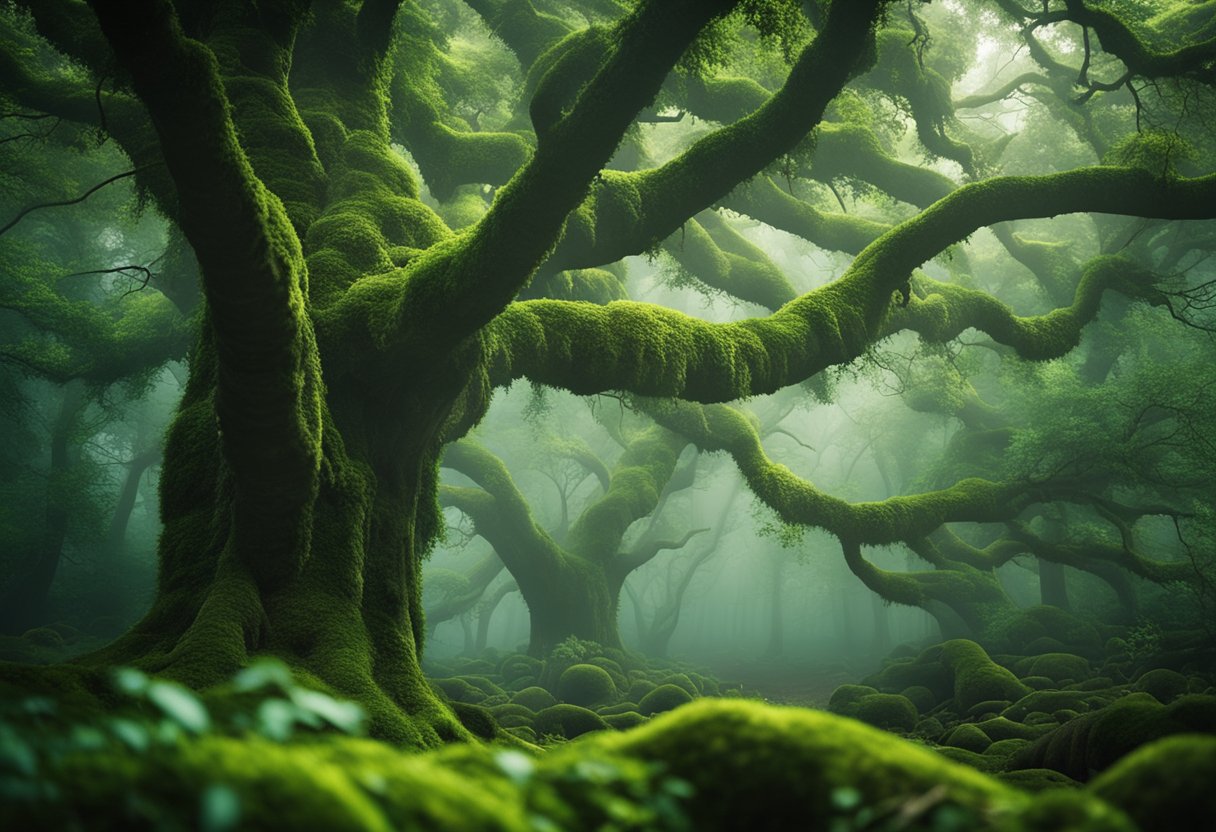
Updated On: April 24, 2024 by Eman Sameh
Ireland’s forests are woven with a rich tapestry of folklore and myth that have survived through the ages, beckoning us into a world where the natural and the supernatural intertwine. Our ancient woodlands are not merely clusters of trees; they serve as living archives of tales and customs, each with its own story to echo through the leaves. As we explore the verdant depths, we uncover the Green Myths that have long filled Irish hearts and minds with wonder.
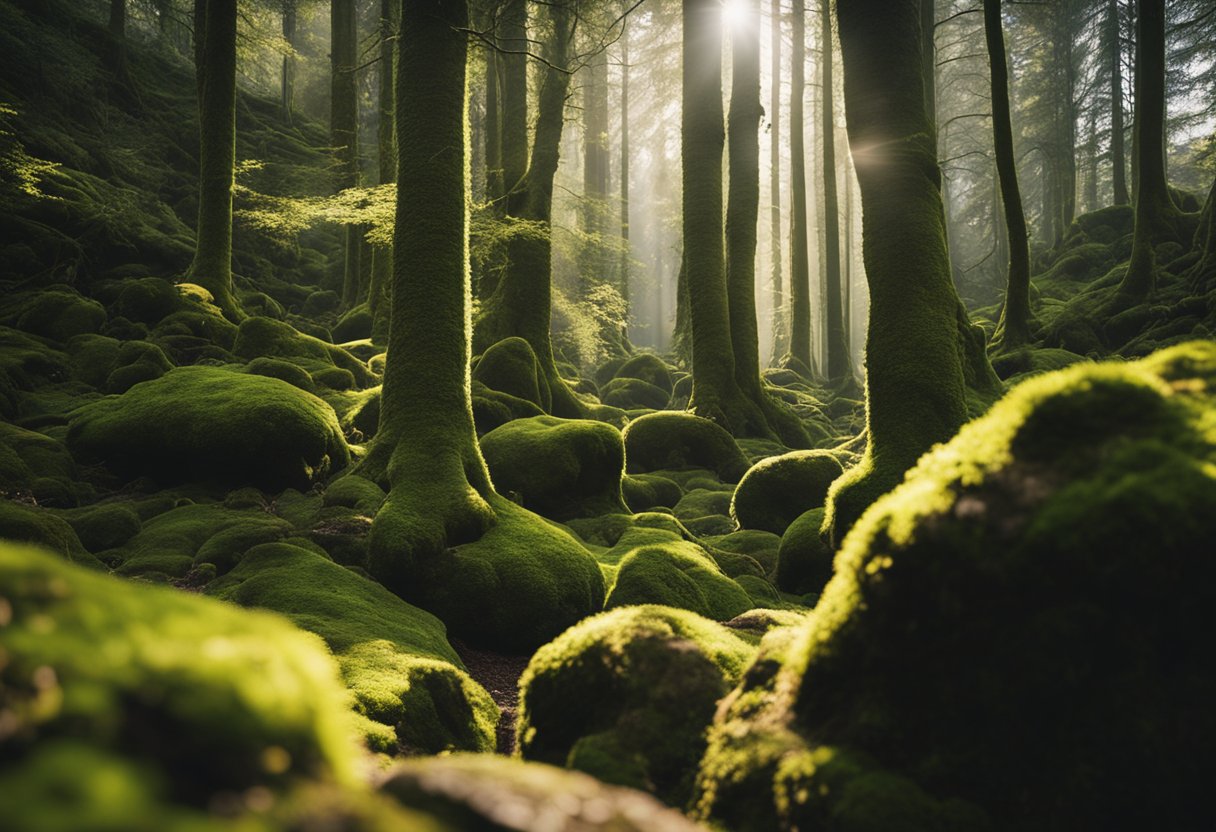
Amidst the whispers of leaves and creaking of branches, the folklore of Irish forests comes to life, revealing an intricate relationship between our people and the sylvan landscape. Significant trees like the mighty oak and the mystical yew are steeped in cultural importance, playing central roles in our legendary sites and ancient traditions. The intertwining of sacred wells, seasonal celebrations, and revered flora within these tales highlights an enduring reverence for the natural world, reflecting a heritage that has weathered the centuries.
The Natural History of Irish Trees
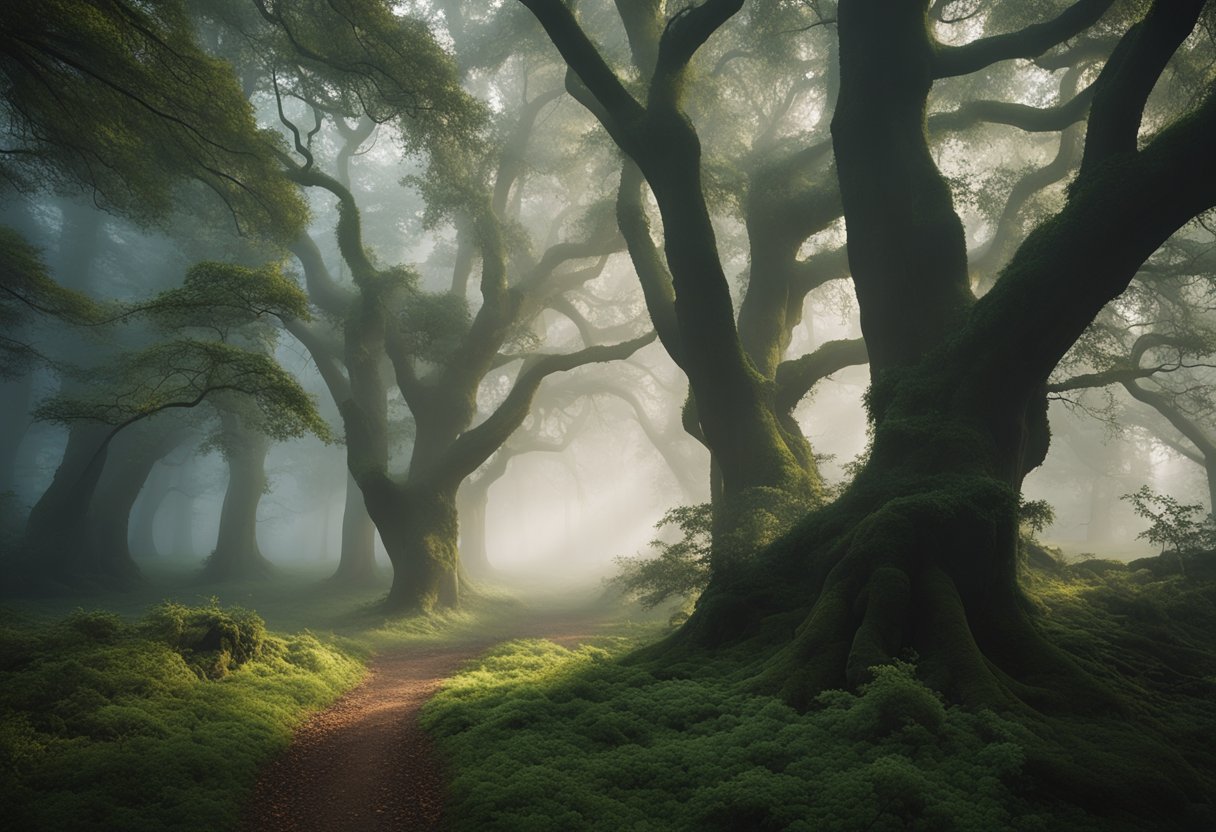
Our journey through the tapestry of Ireland’s natural heritage would be incomplete without discussing the natural history of Irish trees. Ireland’s woodlands are steeped in a rich ecological and cultural background, weaving a story that is both ancient and ever-evolving.
Native Trees: Ireland’s woodlands have been shaped by millennia of natural processes and human interactions. Among the native species, the resilient oak and the graceful ash stand prominently, having flourished since the last ice age. These species have not just survived but adapted to the island’s varying climate and have become integral to the biodiversity of Ireland.
Woodlands: Today’s woodlands are remnants of vast ancient forests that once covered the island. Industrialisation and agriculture have significantly transformed the landscape. However, dedicated conservation efforts aim to protect and regenerate these precious ecosystems.
Biodiversity: The native woodlands are biodiversity hotspots. They support various flora and fauna—providing shelter and nourishment to a diverse range of wildlife. In the intricate dance of ecological interdependence, these trees are pivotal.
Irish Trees in Folklore: Beyond their ecological importance, they are also entwined with Ireland’s folklore and history. The sacred oak, yew, and ash, for instance, are symbols deeply rooted in Irish mythology and continue to fuel imaginations and cultural identities to this day.
We respect our forests for their ecological role and cultural significance. Through engagement and education, we aim to foster an understanding that will ensure the survival and flourishing of Ireland’s native trees and woodlands for generations to come.
Irish Folklore and Mythology

In our exploration of Irish forests, we uncover the rich tapestry of myth and folklore deeply rooted in the landscape. Trees are not just botanical entities; they are central characters in Ireland’s mystical heritage.
Mythic Trees and Legendary Tales
Trees in Irish folklore hold profound significance, often intertwined with stories of the Sidhe, or fairy folk, believed to inhabit a magical Otherworld. For example, the mighty oak, ash, and hawthorn are sometimes seen as sacred trees thought to serve as gateways to this enchanted realm. Tales told through the generations speak of these trees as protectors of secrets and keepers of ancient wisdom.
The Magic and Enchantment of Trees
Beyond mere symbols, trees in Irish tradition are vested with magic and enchantment. Whispering leaves and stoic trunks are thought to be imbued with the spirits of the land, and some tales suggest that certain trees can confer blessings or curses upon those who interact with them unwisely. It is this mystical aspect that continues to fuel the folklore surrounding Ireland’s wooded glades.
Ogham and the Sacred Language of Trees
Finally, the connection between Irish forest folklore and its ancient script, Ogham, is undeniable. Frequently referred to as the ‘tree alphabet’, each character within the Ogham script corresponds to a specific tree or shrub, highlighting the reverence our ancestors held for the forest. This script is more than a writing system; it’s seen as a sacred language, bridging the human and arboreal worlds.
Significant Trees in Irish Culture
In Irish culture, certain trees hold profound significance, steeped in ancient folklore and regarded as sacred entities within both natural and mystical realms.
Oak: The Mighty
The oak tree represents endurance and strength. In our tales, it’s often considered the most sacred tree, with a stature befitting its regal status amongst the forests. It’s believed to be a source of wisdom and was once central to the Celtic religion, where druids would hold their gatherings in the presence of these towering trees. Their longevity and imposing presence rendered them as symbols of power and survival through the ages.
Rowan: The Protector
Rowan trees, with their distinctive red berries, act as guardians in our folklore. They are thought to ward off malevolent spirits and are commonly known as ‘the protector’. It’s common in stories for a rowan to be planted near homes specifically to prevent enchantment by fairies. Its wood is also deemed powerful, and it is used to craft wands and walking sticks infused with the essence to protect and heal.
Hawthorn: The Fairy Tree
The hawthorn tree carries a more enigmatic aura. Often referred to as ‘The Fairy Tree,’ it is believed to be a portal to the otherworld of the fairies. Interference with a hawthorn is avoided in fear of attracting fairy wrath. When standing alone, these trees are specially treated with reverence and are central to many tales involving spirits and the supernatural.
Hazel: The Wiseman
Lastly, the hazel tree is synonymous with wisdom and inspiration in Irish mythology. Ancient tales speak of hazel nuts falling into sacred pools and being eaten by salmon, which would then possess all the world’s knowledge. The hazel is also associated with poetic inspiration, with the nuts representing nuggets of wisdom.
Each of these trees is more than just a plant; they are characters in the rich tapestry of our land’s narratives, shaping the spiritual landscape as much as they have the physical one.
Legendary Sites and Ancient Trees
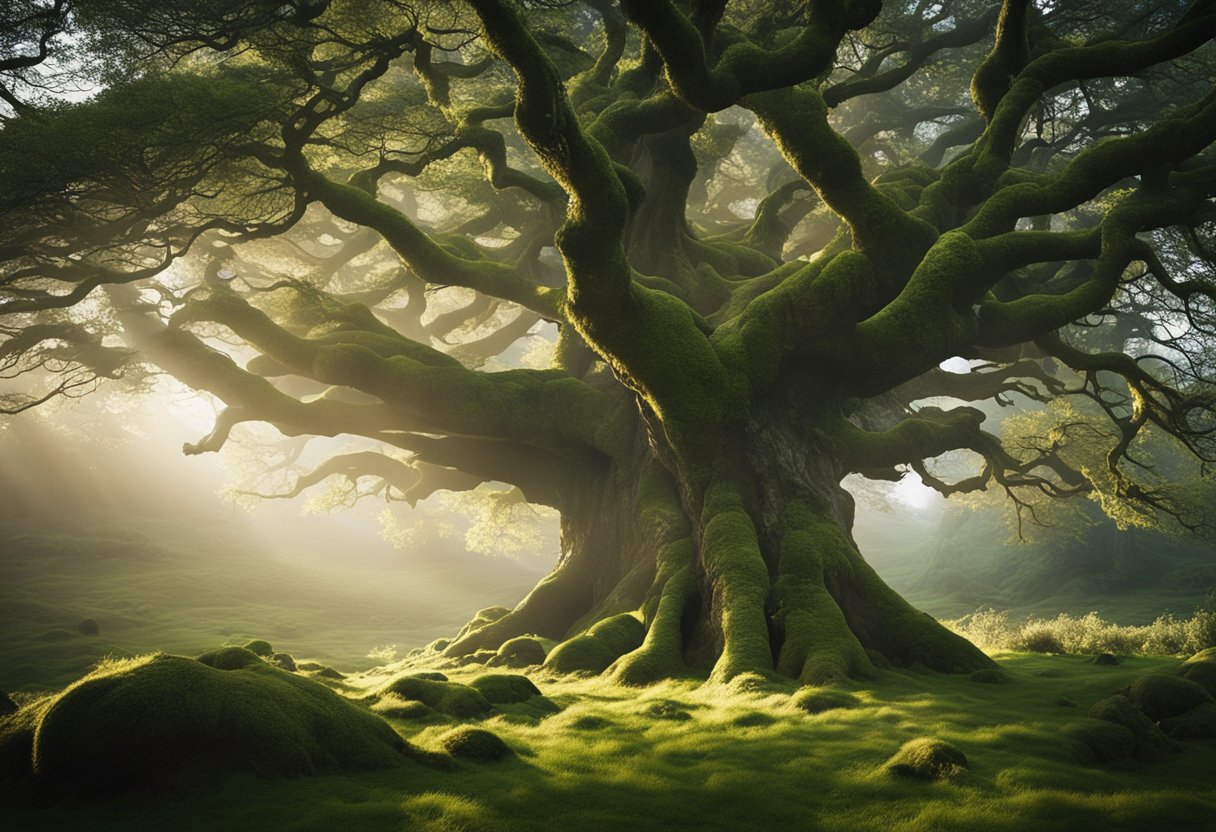
Ireland’s rich tapestry of history is deeply woven with the legends surrounding its ancient trees and mythical landscapes. These natural monuments have stood as silent witnesses to the passage of time, often connected to the lore of the Irish who hold them in high reverence.
In locations such as Derry, one finds a landscape punctuated with such spirited trees. The city’s very name derives from the Irish word Doire, meaning ‘oak grove’, a testament to the dense woodlands that once thrived there.
The trees of Ireland are not mere plants; they embody the mystical essence of the land. The bile—sacared trees—were central to spiritual and civic life, often marking the royal sites, places of inauguration, and gathering. Bile Tortan, an ancient yew tree associated with the church of Tortu, is one such tree that was considered a sacred monument, linking realms of the mortal and the divine.
Oak was frequently used in construction on the artificial islands known as crannógs due to its strength and availability. For instance, an excavated crannóg at Ballinderry revealed oak planks and piles, a testament to the resourcefulness and reverence of the oak.
- Key Elements of Irish Tree Folklore
- Sacred Trees: Associated with divine healing and ancient ceremonies.
- Crannógs: Crafted using robust oaks for settlement construction.
- Royal Sites: Often marked by prominent trees, signifying power and lineage.
Our heritage describes these trees and sites not merely as historical curiosities but as vital components of the cultural and spiritual topography that shapes Ireland’s identity today.
Trees and the Brehon Laws
In our exploration of Irish folklore, we must acknowledge the profound legal significance of trees under the Brehon Laws. These ancient Irish laws, sophisticated for their time, classified trees in a way that mirrored society’s hierarchical structure.
Airig Fedo, or ‘nobles of the wood’, sat atop this arboreal hierarchy. Critical to both the economy and culture, these trees included species such as:
- Dair (Oak)
- Coll (Hazel)
- Cuileann (Holly)
- Ibar (Yew)
- Uinnius (Ash)
- Ochthach (Scots Pine)
- Aball (Crab Apple)
Under Brehon Law, the theft or damage to these noble trees was met with severe penalties, often proportional to the tree’s societal value and its role within the ecosystem. For instance, the oak held immense value, not only for its strong and precious timber but also as a symbol of strength and endurance, leading to harsher repercussions for any harm caused to it.
Trees in lower classifications still held importance, albeit with lesser protection and penalties. Yet, all were guarded by the law to some extent, showcasing a remarkable early legal recognition of environmental principles and the symbiosis between humans and nature.
Our legal systems have evolved, but the Brehon reverence for nature endures, influencing current views on conservation and environmental law. It reminds us of our responsibility to sustain and uphold the natural world, which, much like the Law itself, forms a foundational pillar of our society’s structure.
Forests and Fauna
In Ireland’s verdant forests, faunal biodiversity is as rich and varied as the emerald hues that paint the landscape. Our exploration unveils the intricate ecological tapestry where wildlife thrives, sheltered by the canopy above.
The Fauna of Irish Forests
The native forests of Ireland are a sanctuary for a plethora of wildlife, each species an integral thread in the fabric of the ecosystem. Amongst the dense foliage and towering trees, one might glimpse the elusive pine marten, its numbers, once dwindling, now bolstered in these secure habitats. Red squirrels forage in the trees, their presence a testament to the forests’ role in providing shelter and sustenance. Meanwhile, the air resonates with the melody of bird songs, from the sharp call of the jay to the soothing whisper of the wood pigeon.
Forest floors, often shrouded in moss and ferns, are home to an array of invertebrates, vital pollinators that navigate through the understory. These small yet significant creatures contribute immeasurably to the region’s biodiversity, ensuring the perpetuation of both flora and fauna within these sylvan realms.
Habitats and Ecosystem Services
Irish forests assume the valorous responsibility of providing crucial ecosystem services and protecting and sustaining life in various forms. The latticework of roots and soil acts not only as a physical shelter for underground dwellers but also as a natural filtration system, purifying the water table beneath. Each tree, a sentinel of sorts, plays its role in sequestering carbon and mitigating the impacts of climate change.
In terms of habitat provision, the forests form a mosaic of unique zones, each tailored to the needs of different species. The interplay between light and shadow, woodland density, and the presence of water bodies creates niches that foster an impressive range of organisms. From the open woodland where deer graze to the secluded groves where badgers set their dens, the forests offer an irreplaceable haven to Irish wildlife, thereby enriching our nation’s cherished natural heritage.
Sacred Wells and Water in Folklore
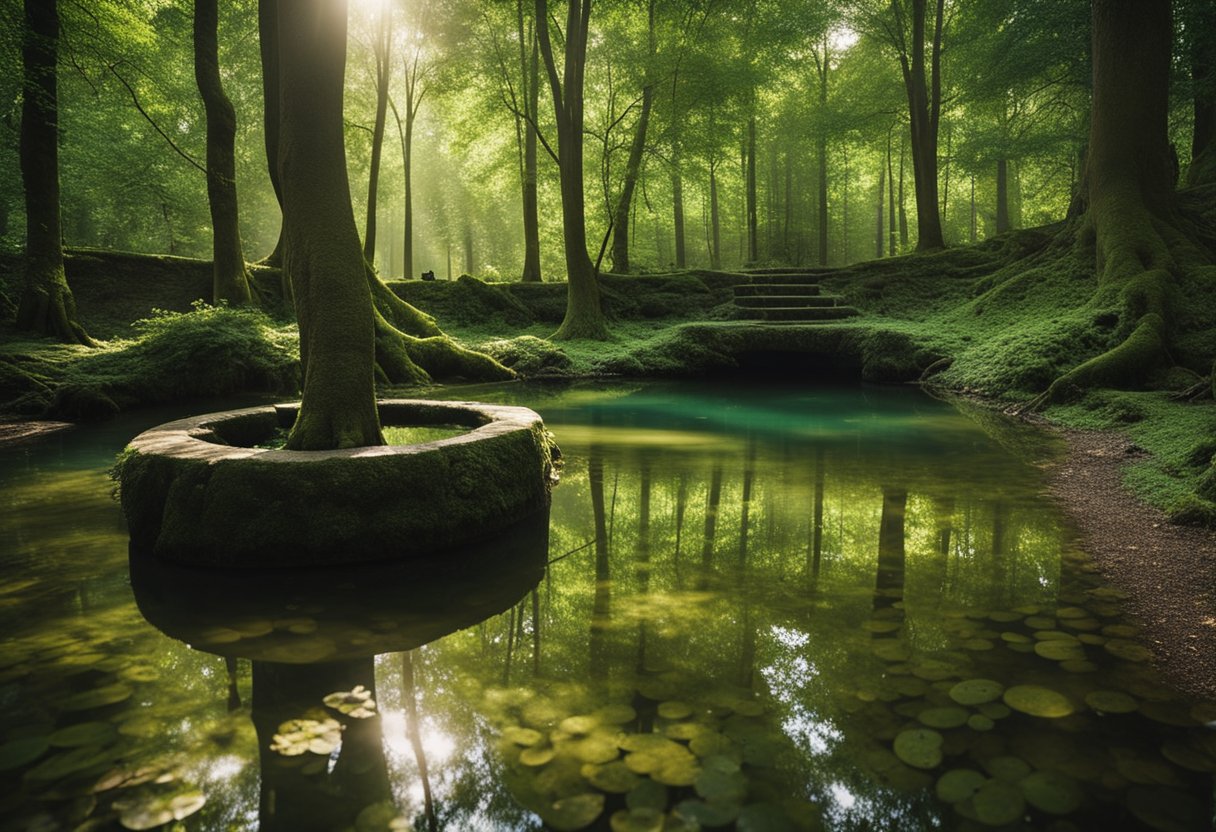
In Irish folklore, water holds a significant place, with many customs and beliefs rooted in sacred wells and springs. Often, these bodies of water were not just seen as natural features but were imbued with deep spiritual meaning.
The holy wells of Ireland are traditionally believed to possess healing properties. The act of visiting a well, commonly tied to folk customs, involves rituals such as “rounding”, where visitors walk around the well, usually in a sunwise direction, while praying. This practice underscores the water’s perceived power to heal and cleanse.
Further emphasising the importance of water in folklore, these sites are frequently associated with fertility. Many are dedicated to saints and are sites of pilgrimage, especially on certain “patterns” or feast days, which showcase the well’s link to prosperity and well-being.
Notably, the lore surrounding such wells and springs often includes miraculous tales; for instance, water’s link to the gift of life, both physically and spiritually, is a common theme. Moreover, it is not uncommon for them to be portrayed as gateways to the Celtic Otherworld, highlighting a more mystical dimension of water in the cultural heritage.
In the folk traditions we observe, sacred wells and elemental waters are revered for their supposed divine connection. As such, these sites remain an integral part of the cultural landscape and continue to attract those seeking to honour the old ways.
Folk Customs and Seasonal Celebrations
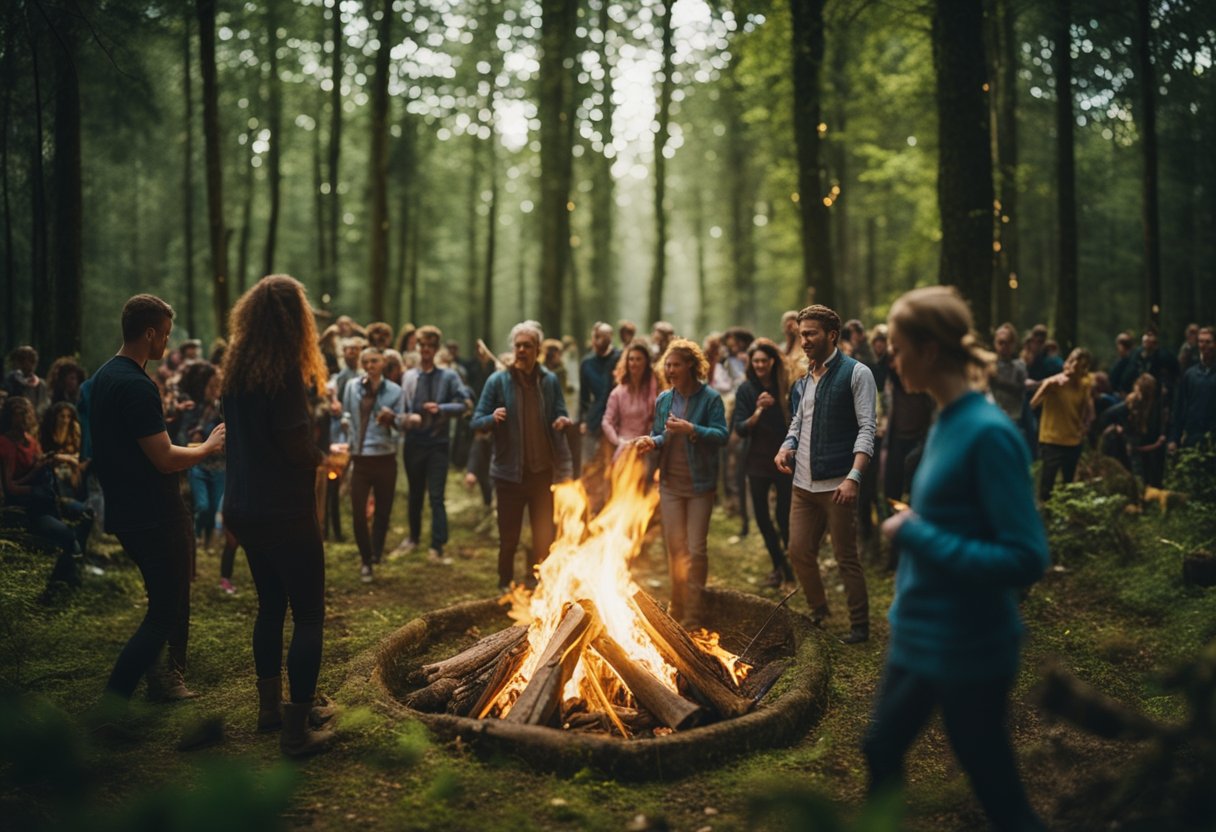
In Ireland, the tapestry of our folklore is intertwined with the changing seasons, with each turn of the year marked by age-old traditions.
Autumn: Perhaps most vividly, autumn heralds the time of harvest. It’s a period when we gather the fruits of the land, and our customs reflect our gratitude for this bounty. The last sheaf of the harvest is often celebrated with particular reverence, symbolising both the end of the harvest and the sustenance it provides.
- September: We often associate this month with the beginning of the harvest and the start of reaping what has been sown. It’s a time of hard work, but also a celebration as the fruits of our labour are finally collected.
- October: As the month progresses, we inch closer to Samhain, an ancient festival that marks the end of the harvest season and the beginning of winter. Samhain is a time when it’s believed that the veil between our world and the next is at its thinnest and when we honour those who have passed.
- November: The harvest is usually complete by November, and our attention turns towards preparing for the winter months.
Throughout these autumnal months, we find numerous folk customs. From sharing stories and music to communal feasting, each act is steeped in tradition. It’s a poignant reminder of our connection to the land.
These rituals truly show the fusion of the natural world with the cultural fabric of our society. By upholding these practices, we not only honour the legacy of our ancestors but also impart a sense of rhythm and belonging to our own lives amidst the perpetual cycle of the seasons.
The Flora of Irish Folk Tales
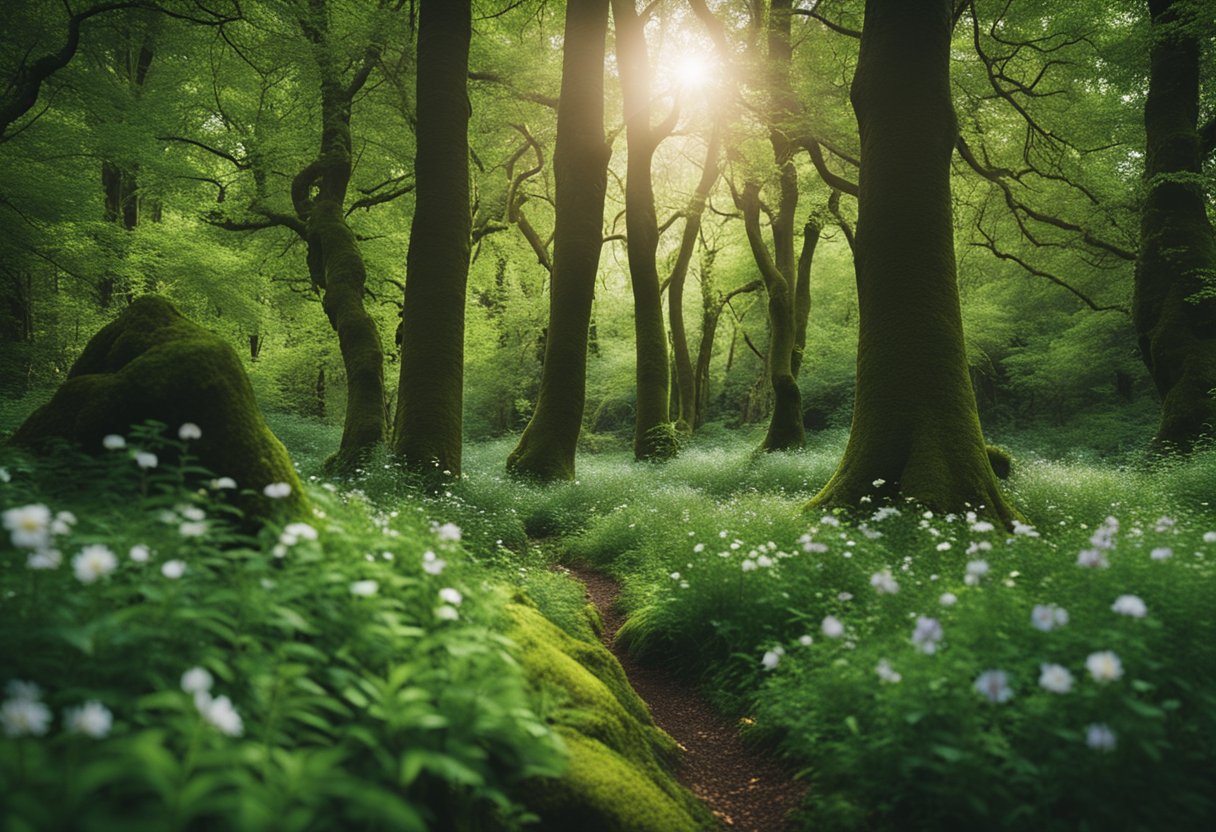
The plants of Ireland’s forests have been imbued with meaning and mystery in myth and folk tradition. They serve as key characters and symbols in stories passed down through generations.
Plants with Mythical Significance
Certain trees stand out in the tapestry of Irish folklore for their symbolic importance. Hazel is one of these, often associated with wisdom and knowledge. It is said that hazelnuts fall into the Well of Wisdom, eaten by the salmon of knowledge. Likewise, the elder tree is considered protective while also being connected to the otherworld due to its use in magic and medicine.
Holly is another significant tree, traditionally seen as a symbol of protection and good fortune. Planted near homes, it was believed to guard against negative spirits. The alder, associated with the element of water and the fairy realm, held its own mystique, while blackthorn had connections to dark magic and was often used for protection due to its sharp thorns.
Willow, known for its link to the world of spirits and enchantment, features prominently in lore related to the goddess Brigid. The birch also holds a place in Irish legends, symbolising renewal and purification – often used in traditional May Day festivals to ward off evil.
Gorse and Furze in Irish Tradition
Gorse (also known as furze) plays a striking role in folklore. Its bright yellow flowers were seen as a beacon of hope and light during the dark winter months, symbolising the sun’s return. The plant had practical uses, such as heating and feeding livestock, showing how Irish folklore often ties the mythical back to the practical realities of life.
Each of these plants brings with it a tale, an association that weaves through the fabric of Irish heritage, creating a verdant lore as enigmatic and deep as the forests themselves.
Botanical and Cultural Names
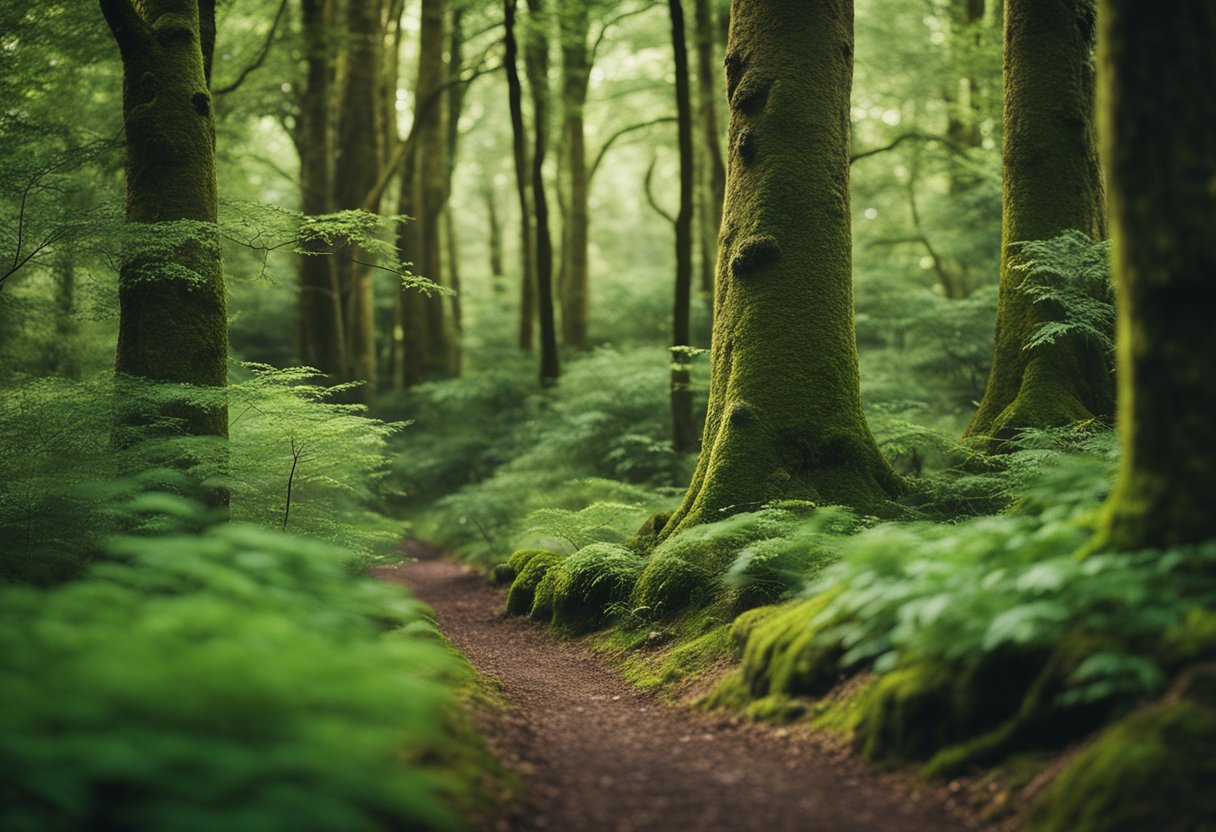
In the rich tapestry of Irish forests, trees hold more than just ecological importance—they are steeped in history and folklore, reflected in the botanical and cultural names rooted in the very fabric of the land.
Place Names and Tree Associations
Throughout Ireland, many places are indelibly linked to trees through their names. These names often bear witness to the trees’ significance, echoing a time when the language of the Ogham alphabet—an ancient script using lines to denote letters—was widely used, with each character associated with a particular tree species. For example:
- Derry: derived from the Irish word “Doire”, meaning oak grove.
- Killybegs: from the Irish “Coillte Beaga”, meaning small woods.
These place names underscore the reverence our ancestors held for these forests and their denizens, serving as a living lexicon of cultural heritage. Some trees have earned cultural prominence due to their prevalence in folklore:
- Apple (*Malus domestica*): Associated with knowledge and the otherworld, apple trees and their fruit feature prominently in Irish myths.
- Yew (*Taxus baccata*): Considered one of the most sacred trees, it is famed for its longevity and is often found in ancient graveyards. It symbolises the link between this world and the next.
- Ash (*Fraxinus excelsior*): Revered for its strength and flexibility, the ash is one of the three main trees of the Brehon Laws classification, highlighting its importance in both practical and mystical terms.
By understanding this connection between place names and tree associations, we gain insights into Ireland’s enduring cultural landscape, where nature and narrative are inseparably entwined.
Conservation of Irish Tree Heritage
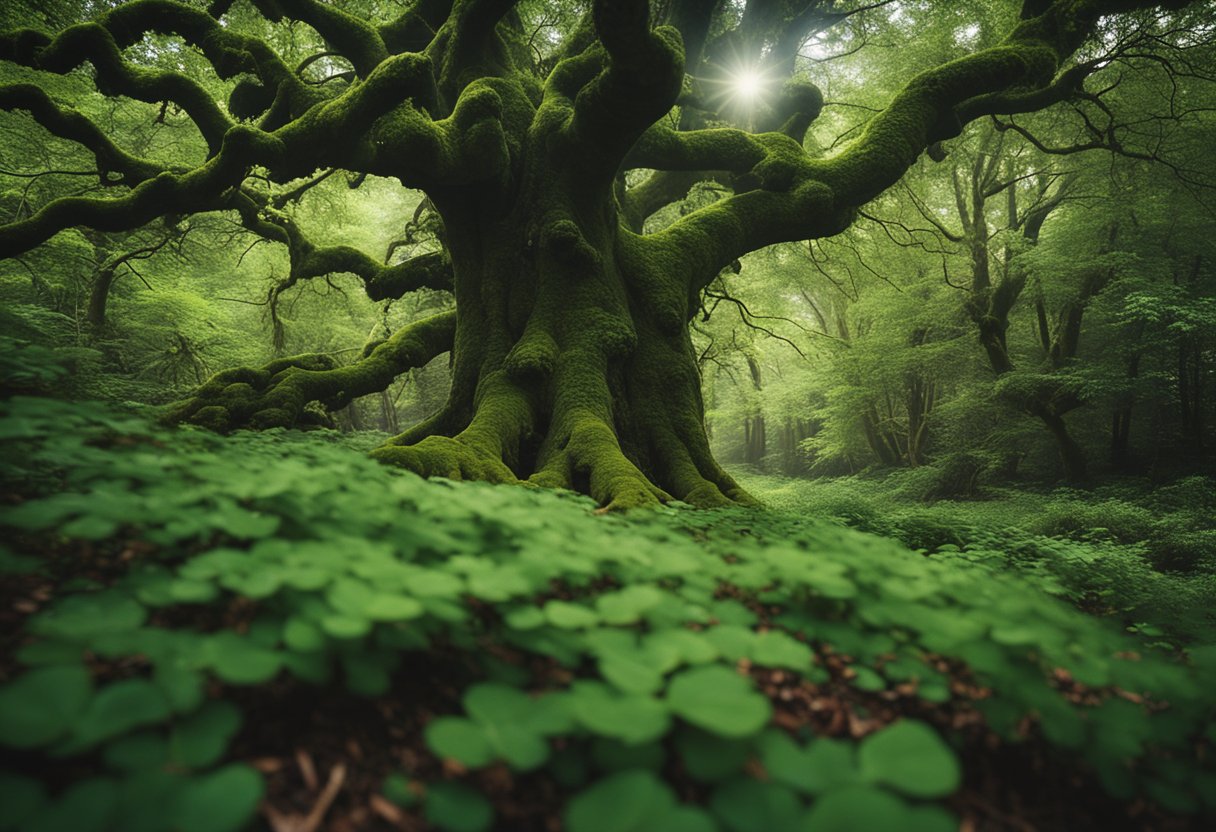
Native Irish trees play an essential role in our pursuit of conservation. These species have been a part of our heritage for centuries, and we must protect this legacy. Let’s consider the measures we are undertaking to ensure the sustainability of our forest heritage.
- Replanting: Utilising seeds from native specimens, we’re actively replanting to rejuvenate ancient woodlands and create new ones.
- Protection: Legislation and conservation bodies work together to safeguard our oldest and most significant trees.
- Education: By raising awareness, we encourage public involvement in conservation efforts.
We commit to using sustainable practices that help preserve our treasured landscapes and contribute to the global fight against climate change. To ensure that these habitats thrive, we balance conservation efforts with responsible woodland management.
It is our responsibility to maintain the continuity of Ireland’s arboreal lineage. We undertake these efforts not just for the intrinsic value of the trees themselves but also to preserve the folklore and culture that have grown around them.
Our collective future is tied to the successful conservation of these natural wonders. We must strive to maintain our heritage for generations to come.
Frequently Asked Questions
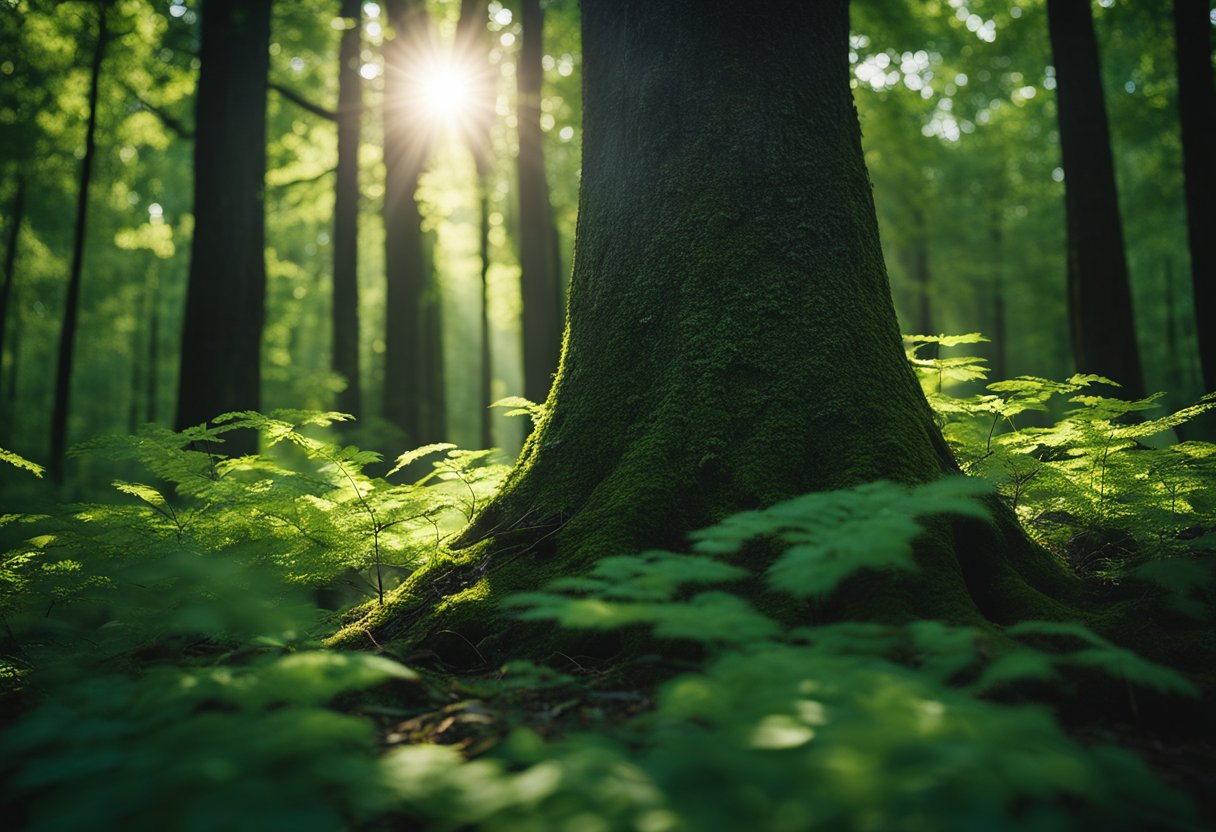
In this section, we address some of the most commonly asked questions about the rich tapestry of mythology surrounding Ireland’s trees and forests.
What are the seven sacred trees of the Celtic belief system?
In the Celtic belief system, the seven sacred trees, also known as the “Nobles of the Wood,” include oak, ash, hawthorn, yew, pine, apple, and willow. These trees are deeply ingrained in the Celtic spiritual world and are celebrated for their unique qualities and connection to various aspects of life.
What stories and beliefs surround the hawthorn tree in Irish folklore?
The hawthorn tree is often associated with the otherworld and is considered a marker of fairy forts or portals to the world of the Aos Sí, the supernatural race in Irish mythology. It is believed to bring good luck and is held in great reverence, with many choosing not to disturb or cut a hawthorn tree to avoid bad fortune.
Can you describe the role of oak trees in Irish mythological traditions?
Oak trees are seen as symbols of strength, wisdom, and endurance. They are often connected to druids and chieftains within Irish mythology. The oak is also associated with sacred groves where the ancient Celts held their important ceremonies and rituals.
What kind of significance do mythological forests hold in Irish legends?
Mythological forests in Irish legends are frequently portrayed as mysterious and enchanting places. They serve as abodes for gods, goddesses, and various mystical creatures. These forests are also seen as gateways to the Otherworld, providing the setting for many transformative journeys in Irish folklore.
What are some legends linked to magical trees in Irish folklore?
Irish folklore is replete with legends of magical trees, such as the aforementioned hawthorn. Other examples include the rowan, believed to ward off evil spirits, and the yew, often found in sacred sites and churchyards, associated with immortality and the connection between this world and the next.
How do hazel trees feature in the myths and folklore of Ireland?
Hazel trees hold a special place in Irish myths, particularly associated with wisdom and knowledge. They are often described as the trees of knowledge, with legends telling of hazelnuts falling into sacred wells and imbuing the water with wisdom, which is then consumed by salmon. The person who catches and eats the salmon is said to gain all the world’s knowledge.






